Ethiopia, Lalibela, 22nd and 23rd of May 2025
A couple of very difficult runs in Lalibela due to the steep hills and the altitude, but worth it for the opportunity to run amongst the vibrant local life, with smiles everywhere. And seeing the locals praying in front of the amazing Lalibela churches!
TLDR; “too long, didn’t read”
- I just want to run! Take me to RUN.
- I have 1 minute. Take me to USEFUL INFORMATION.
- Running is my excuse for travelling. Take me to TRIP.
- Running is my excuse for eating. Take me to CARBOLOADING.
- I want to know what to read in the plane. Take me to ONE BOOK.
Ethiopia’s Running culture!
Just after we arrived in Lalibela, our guide asked us where we were from. We responded with a “Barcelona” which rapidly evolved into a conversation about football and Barça. I asked him if there is strong support for football here and he answered “No, here we like running”.
Running!!
And he made a funny movement which is supposed to mimic running 😅 and mentioned Haile Gerlassie. I mentioned the Big Ethiopian Run, which I would like to run in the future. I also dropped the name Bikila, and he responded super happy with “Tokio!! He won!”.
It was the first time we have a conversation about running and not just football with the locals!
🌍 The trip 📷: What to see in Lalibela in a few days
Nestled in the highlands of northern Ethiopia, the town of Lalibela sits at over 2,500 meters (8,200 feet) above sea level, surrounded by rugged mountains and vast plateaus. The landscape is dramatic and serene—dry cliffs, terraced hillsides, and winding paths lead toward one of the world’s most extraordinary sacred sites.
🕰 A Glimpse into the Past
Built during the reign of King Lalibela (late 12th to early 13th century), the churches were meant to serve as a “New Jerusalem” for Ethiopian Christians unable to make the pilgrimage to the Holy Land.
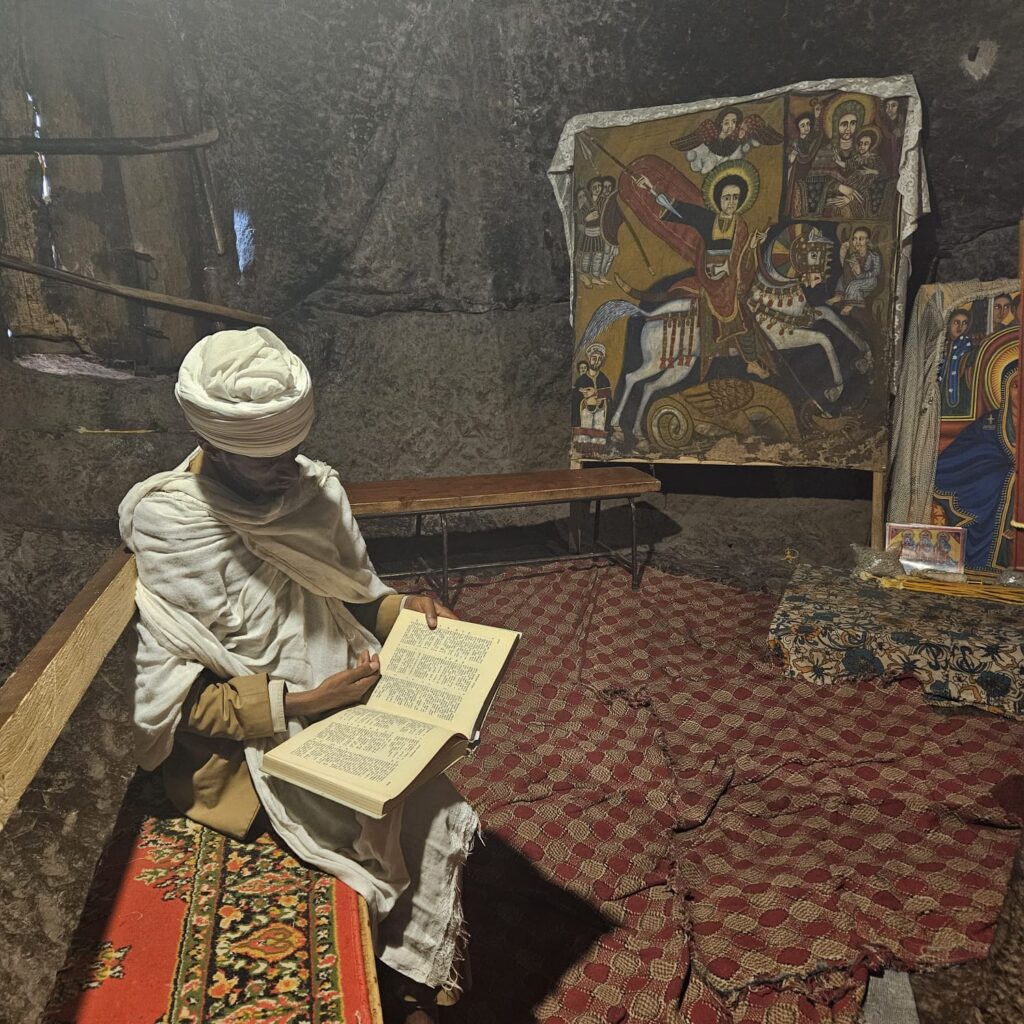
Legend says the king had help from angels during the construction—something you’ll understand once you see the mind-bending complexity of the architecture.
🕍 The Rock-Hewn Churches of Lalibella
The first day we visited the northern church cluster.
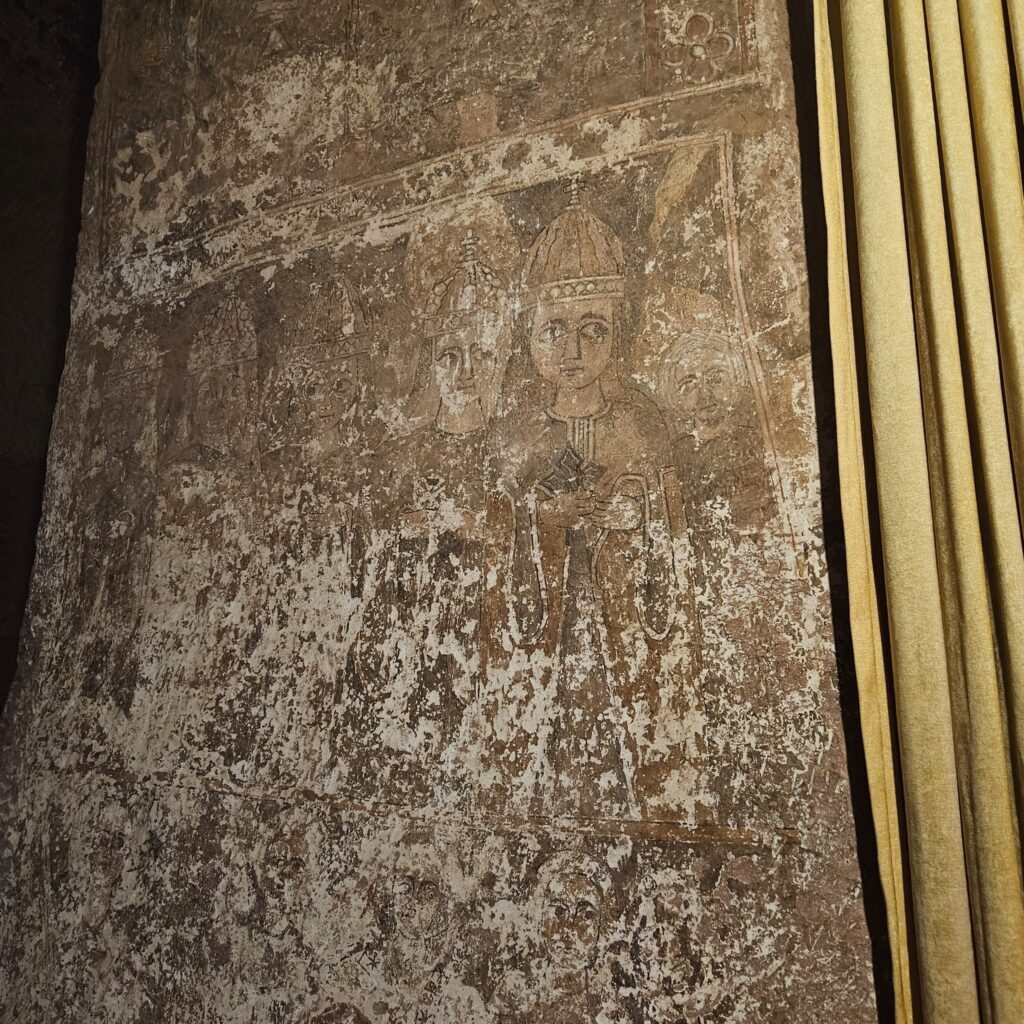
For me, they are totally worth the visit. It’s a very special place where I felt magic around me. I felt it is truly a sacred place, still here from the mists of time, which spoke to me like an old tale of a faith like no other.
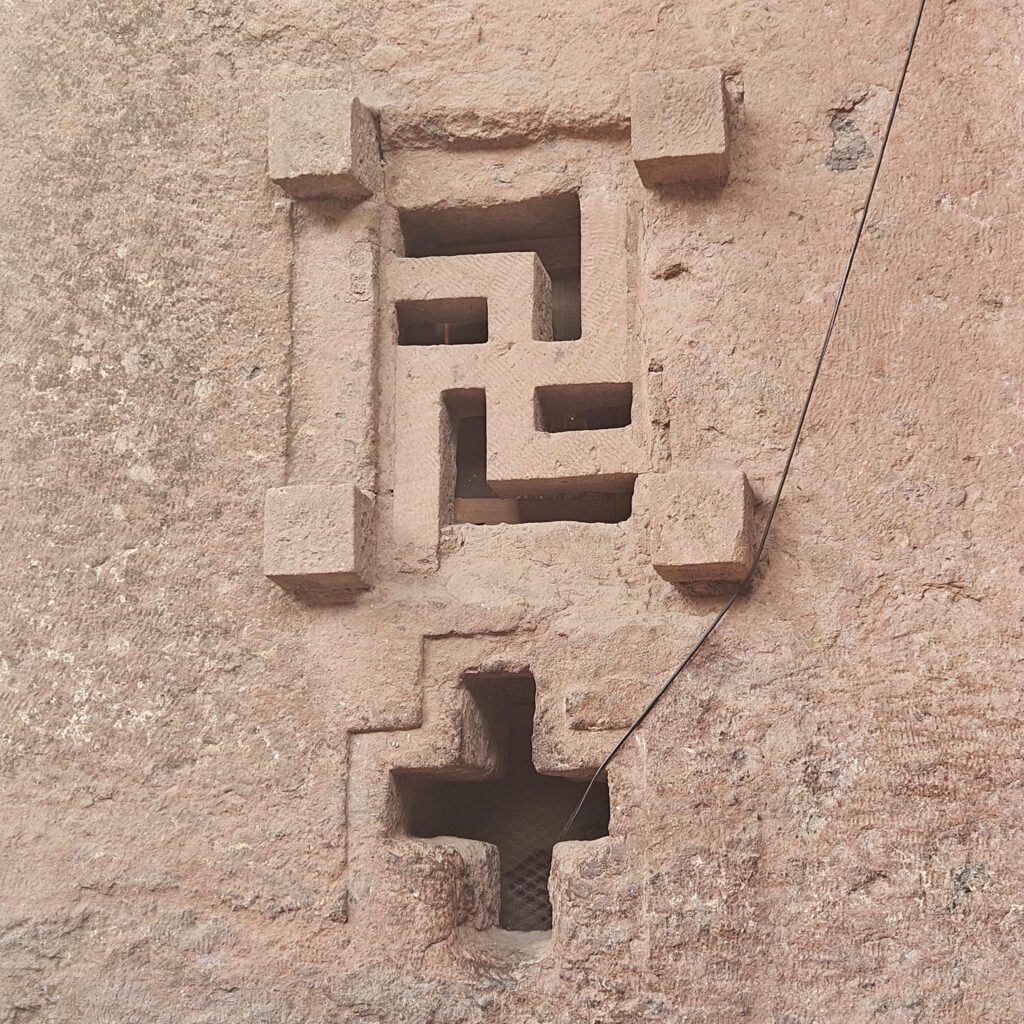
These churches in Lalibela are rock-hewn, they were carved in the rock and when looking at the beautiful work and superb architecture and craftmanship, I could not believe how they did it.
They lie in a sunken, carved-out basin just a short walk from the town center. At first glance, the landscape seems unremarkable—until you peer over the edge and see the colossal trench in which the churches have been carved, not from the ground up, but from the rock down.
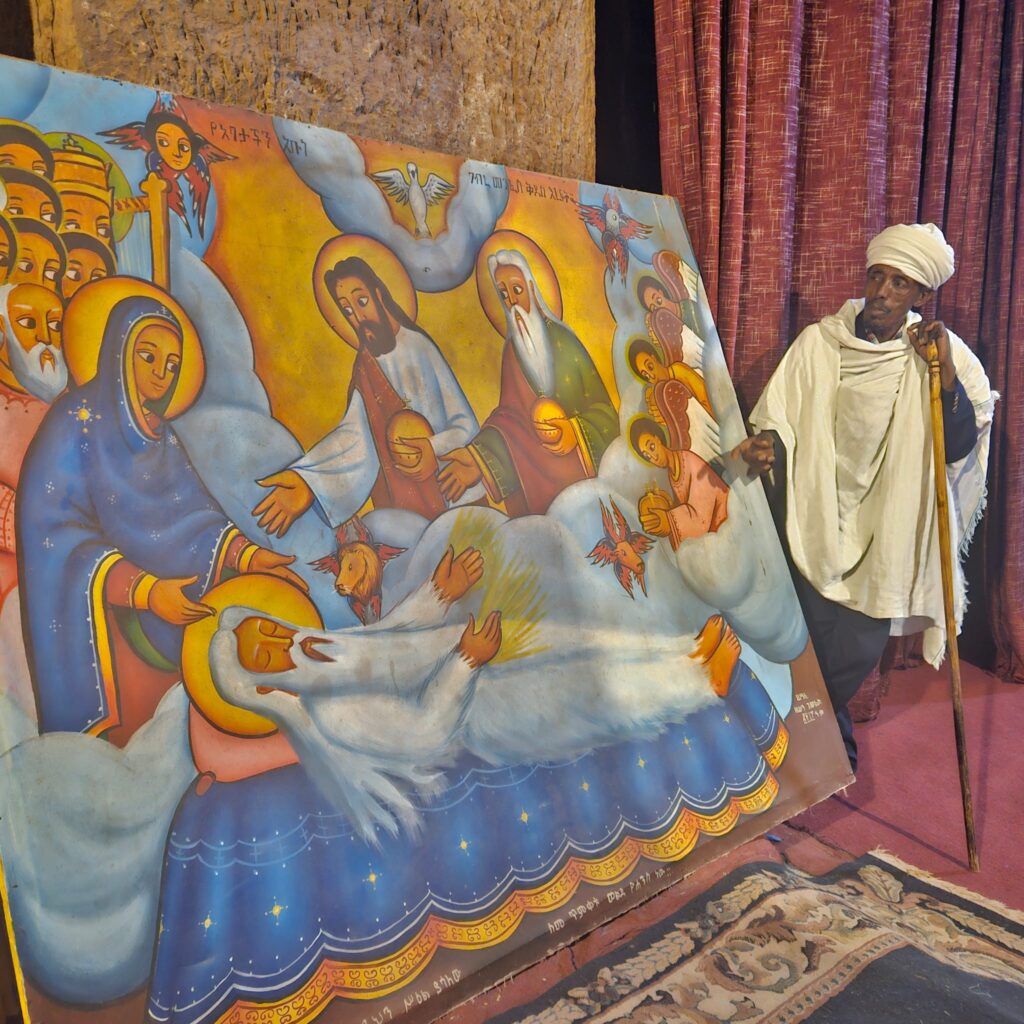
Biete Medhane Alem
Biete Medhane Alem, the House of the Savior of the World, is the largest of the group, and its wide, colonnaded façade resembles a classical basilica.
It stands in a courtyard chiseled deep into the reddish volcanic tuff, with walls that rise up like canyon sides, isolating the space from the outside world. Despite being open to the sky, the air is cool and shaded, and the only sounds are murmurs of prayer and the shuffle of pilgrims’ feet.
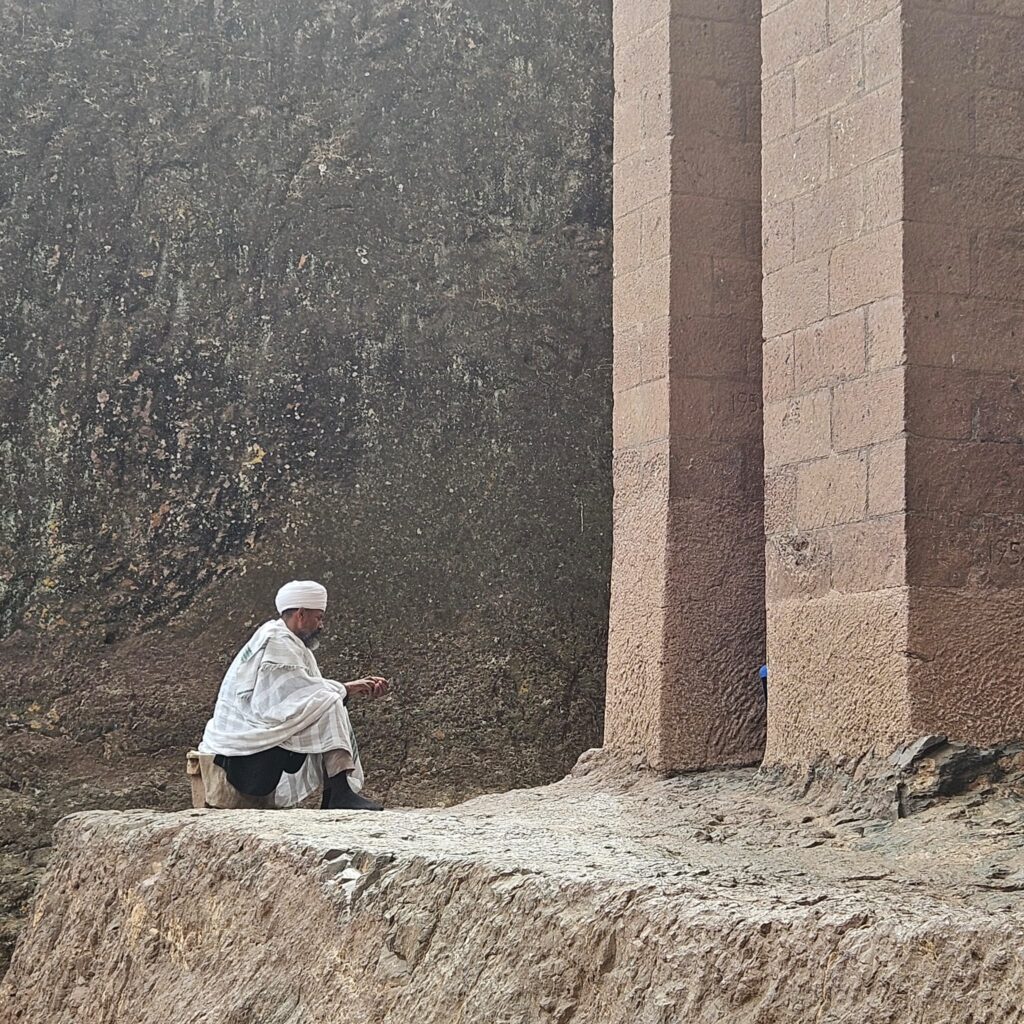
We visited on the 21st of May and it was sunny, a spectacular day. And we were alone! It was the low season and there were no tourists! It was such a great experience to walk around and enter those holy temples by ourselves. The old priests chanting inside welcomed us with a smile, and our guide, Mesfin, explained all the historical details, as well as the famous Christmas celebration in one of the Churches.
Narrow passageways and rock-hewn tunnels connect Biete Medhane Alem to neighboring churches like Biete Maryam, Biete Golgotha, and Biete Maskal.
Biete Maryam, Biete Golgotha, and Biete Maskal
The terrain here is a labyrinth of sacred architecture, where each turn reveals another hidden courtyard, a modest cell for meditation, or a sunken chapel carved with incredible precision. Some walls are etched with centuries-old crosses, and the scent of incense lingers in the cool stone interiors.
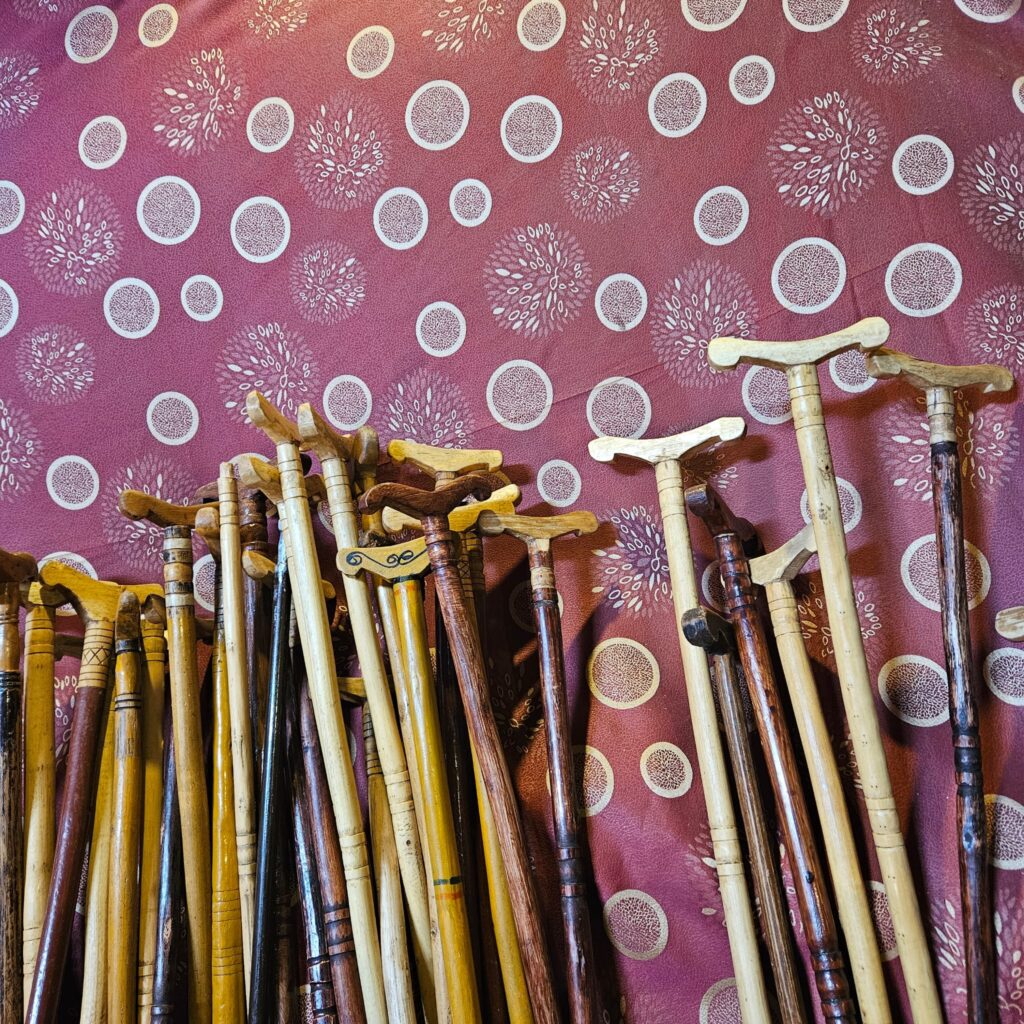
I googled it later and it is, indeed, mesmerising 😲
Now I wanted to come here for Christmas!!!
There were a few locals trying to sell us things, but in general they were not very annoying, and everybody smiled a lot.
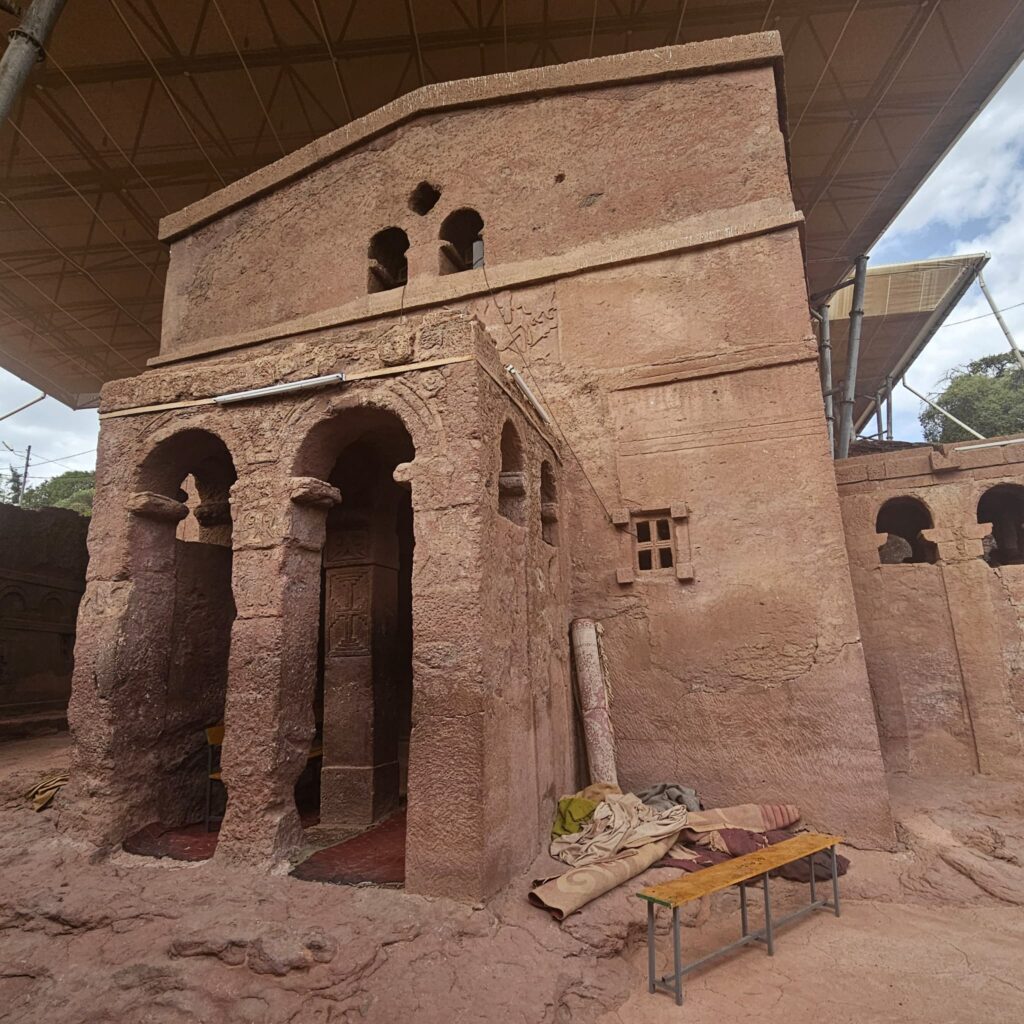
And we even bought a beautiful, beautiful painting of the Virgin Mary with an Ethiopian look, which I found very curious (I am used to baby Jesus depicted as a blond child with blue eyes 🤔), painted in vibrant colours.
🕍 Neakutoleab Monastery
On our second day in Lalibela, we visited the Neakutoleab Monastery. This is a cave monastery, as it is built inside a natural cave, and it is impressive.
Surrounded by mountains, only accessible through a dangerous road which passes villages with mud huts and smiling kids and very old women dressed in bright colours, oh how I was fascinated by it all!
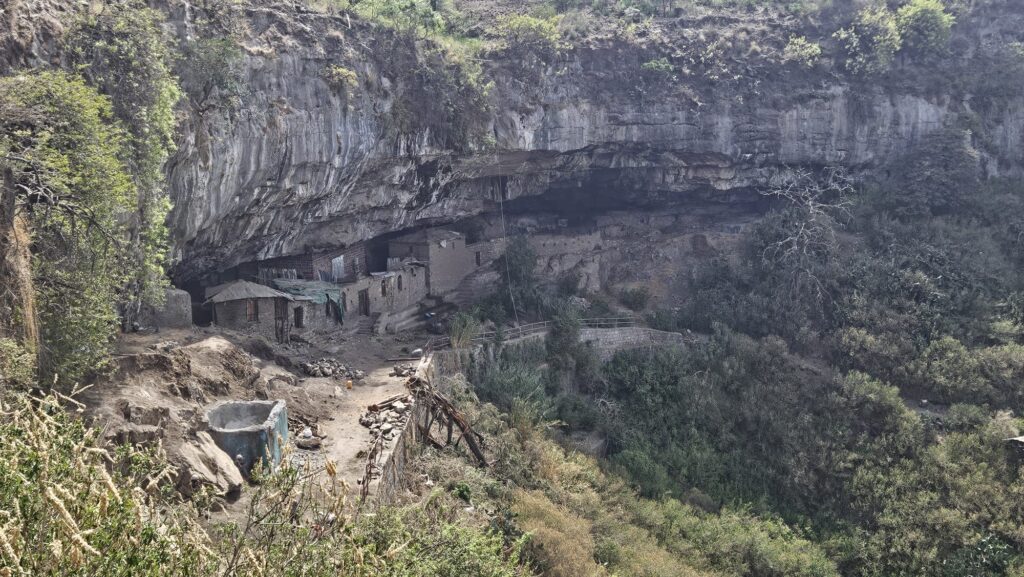
Again, the fact we were literally the only tourists made it very special, and we had the total attention of the priest, which let us drink holy water and also threw water 3 times to our faces (with a lot of energy, I was surprised 🤣).
As per my request, he also touched my injured back with a holy cross… to help my back heal 😇
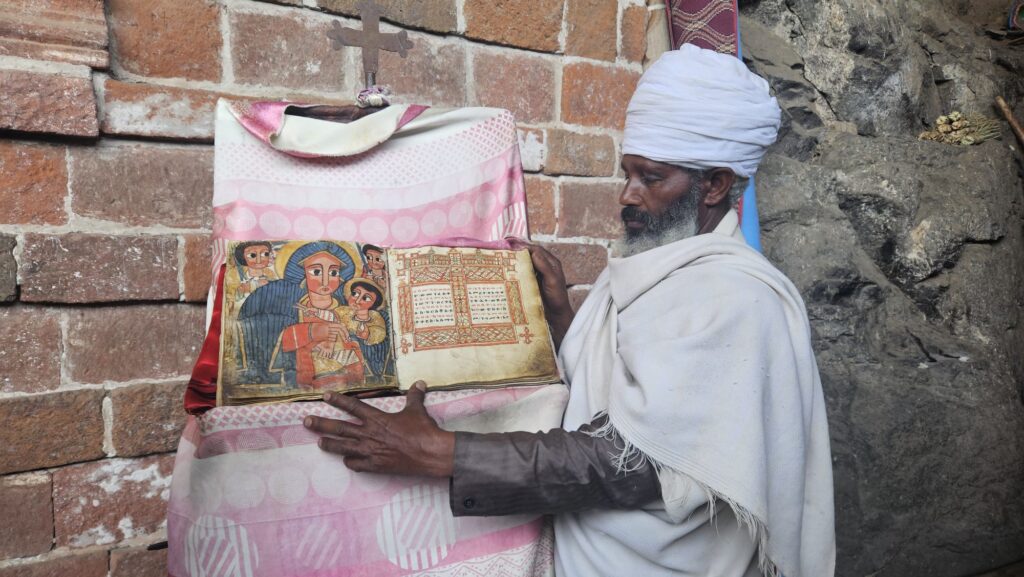
We said goodbye saying something which resembled “Amesegenalo”, which our guide told us meant “Thank you”.
⛪ Church of Saint George (Biete Giyorgis)
Finally we visited the Southern Churches and the very famous St. George’s one, which became my favourite.
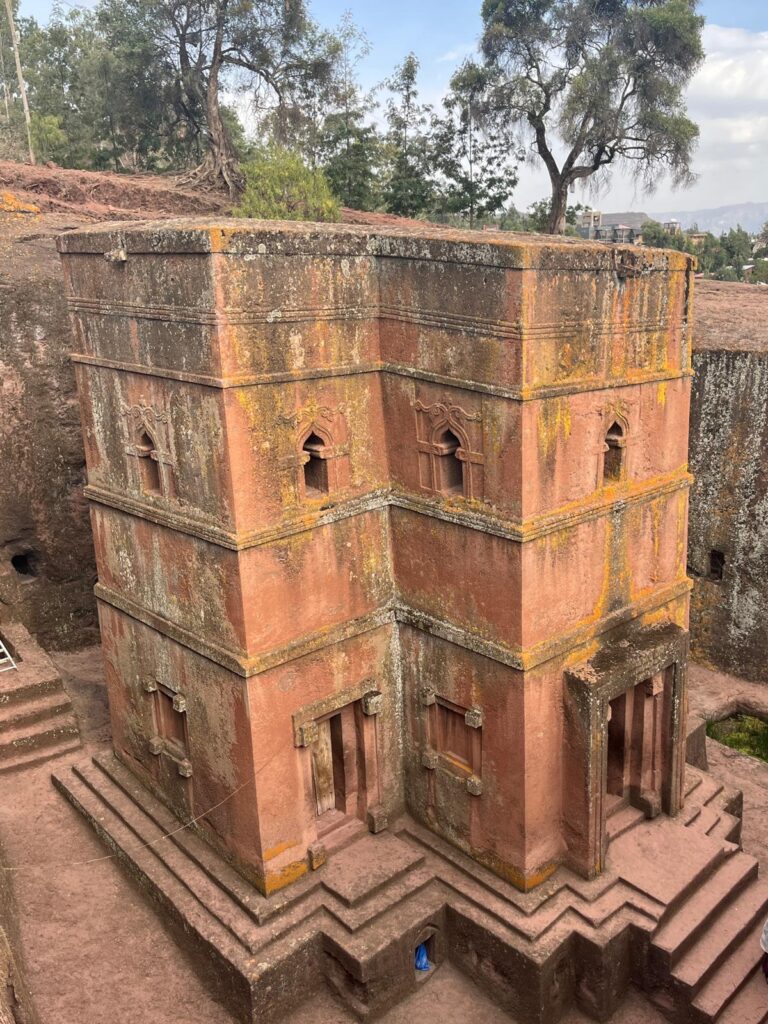
I loved it, and, again, there were no tourists and the silence, the quiet atmosphere and a few locals praying made it more special.
Our guide and the local priests showed us treasures like crosses, or paintings of the apostles and the 3 wise men dating back to the 11th century, or the drums used in celebrations. How cool was that?
I will always treasure what I felt here, the smell of incense, our voices echoing inside, the touch of the cold columns and the carpets covering the irregular stones at our feet.
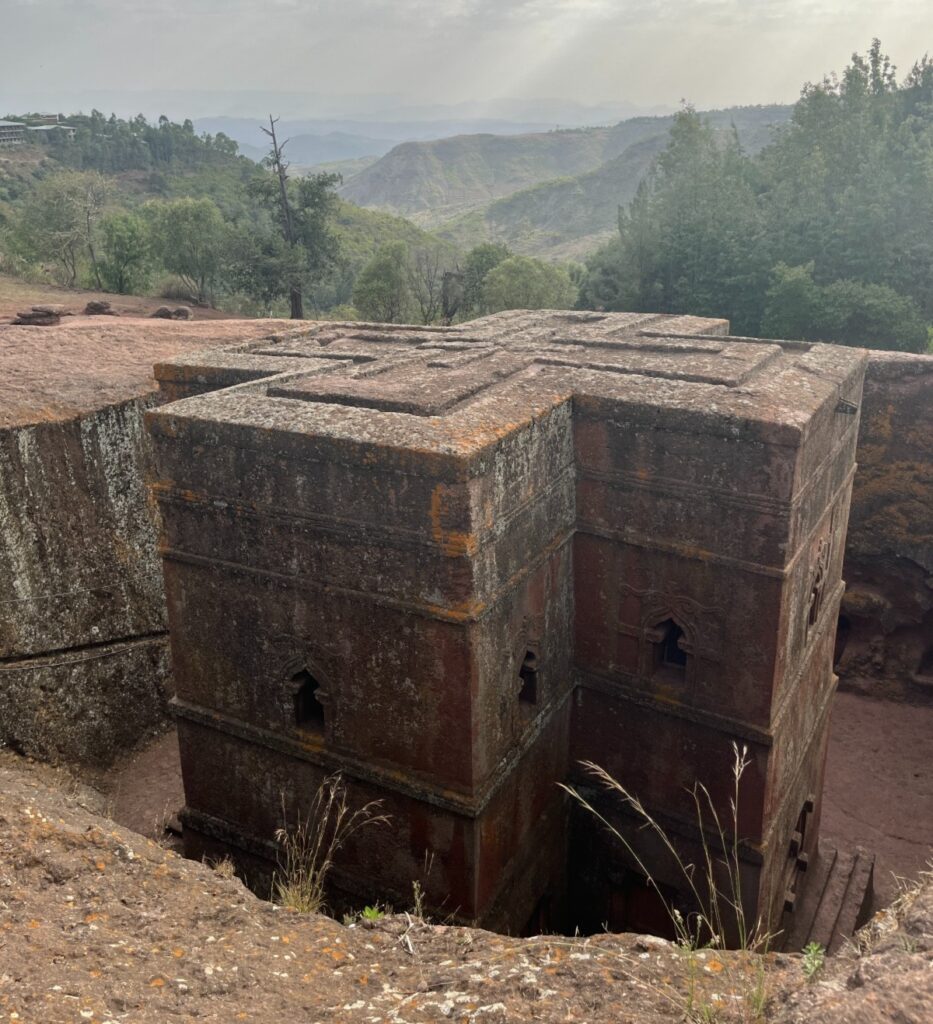
Arguably the most iconic of all the churches in Lalibela, Biete Giyorgis is carved in the shape of a perfect Greek cross and sinks 12 meters below ground level. It’s not just photogenic—it’s awe-inspiring in its precision and symbolism. According to legend, King Lalibela carved it after receiving a vision from Saint George himself. Pilgrims still come barefoot to pray here, believing the church has divine origins. The isolated setting and the near-silent atmosphere around the church add a surreal, sacred aura.
🏃♀️ The run(s)🏃♂️
Lalibella is 2400 high and on my first day, I felt slightly dizzy. Which might had to do also with the fact we slept only two hours in all, today 😰
And it is super hilly, so I was not sure how easy it was going to be for running. Not a lot of traffic, apart from hundreds of blue Tuk tuks with white caps. And it looked vibrant and colourful. I was looking forward to running here.
First run
So, on the second day in Lalibela, we did run!
We woke up at 6:30 am to avoid the heat, which proved a good idea. We decided we would do a short run, to scout the surroundings, as we were not sure of the terrain or if we were to find stray dogs.
But there were none, which was great.
There were a lot of children!
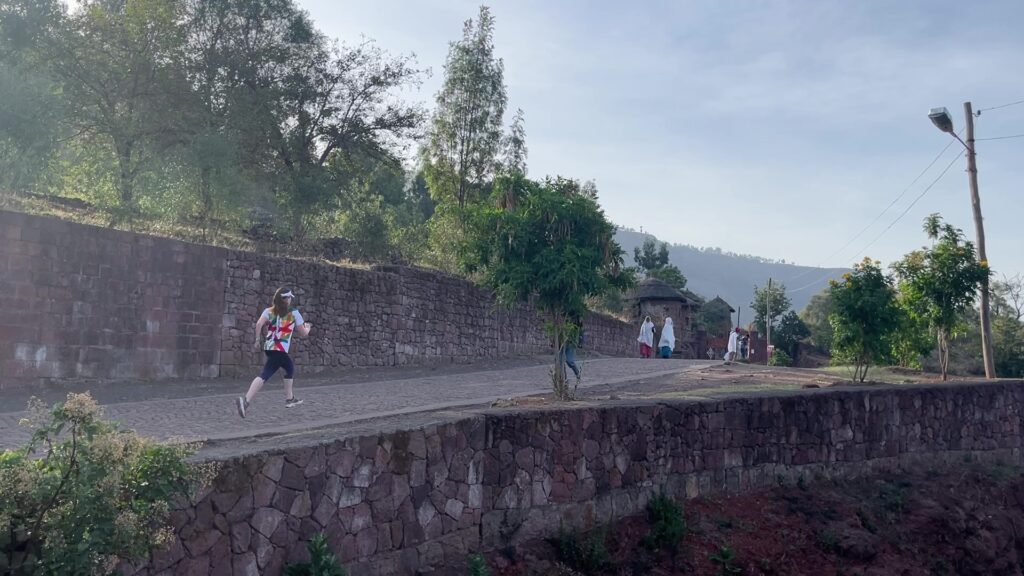
Hundreds of them, coming from the upper parts of town to school in the city centre. They smiled and laughed at us and made our run very enjoyable!
Starting with a climb…
We started and finished in front of the Poly Technic College, in a square presided over by a magnificent tree! Here there were many youngsters waited and some tried to engage in conversations and ask for money for books and school, or their grandma 🙃, but they weren’t too pushy and it was ok.
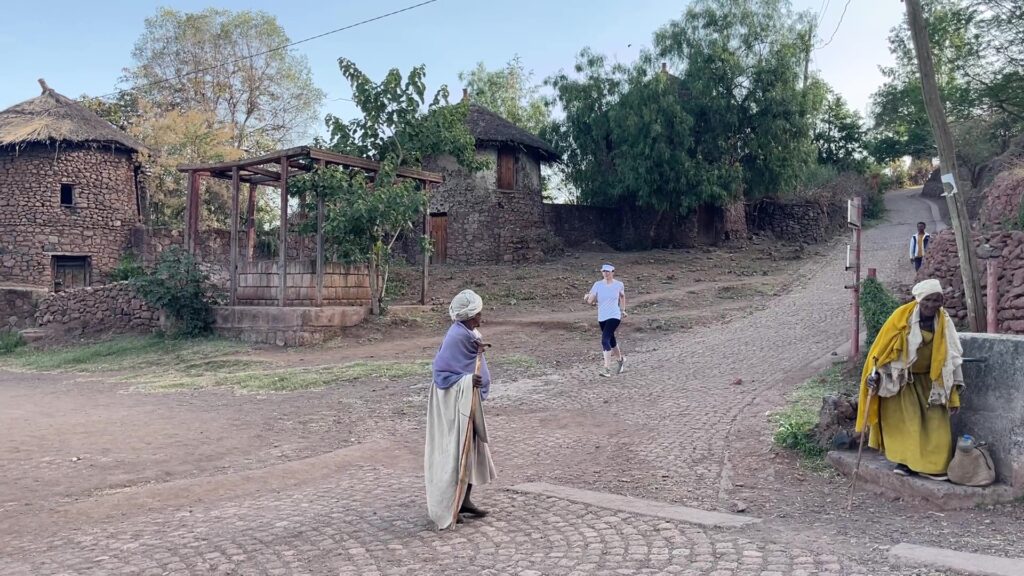
We did struggle with the run, though. Especially as we started uphill, from the hotel to the churches, and it was steep and the altitude knocked me down: I did not stop, as my running pride prevented me from it, but I ran quite slowly.
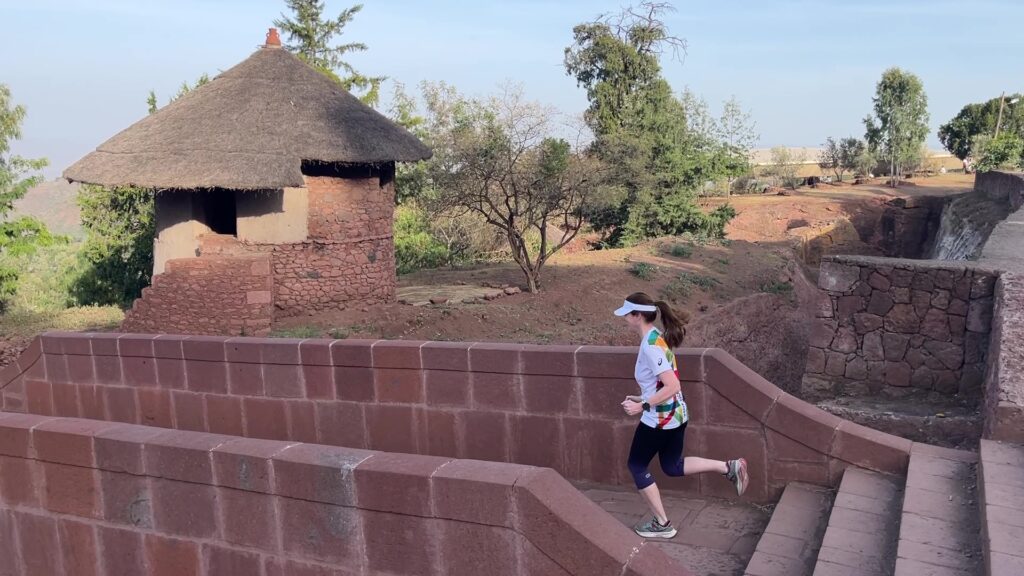
The locals shouted at us things like “Running, running!”, and a bunch of builders smiled and made fun and said “Nice work, lovely” 👏 in English so.. how could I stop?
The “Northern Cluster” of churches
We arrived at the “Northern Cluster” of churches but we did not enter as we had to pay a ticket, and we could do some rest.
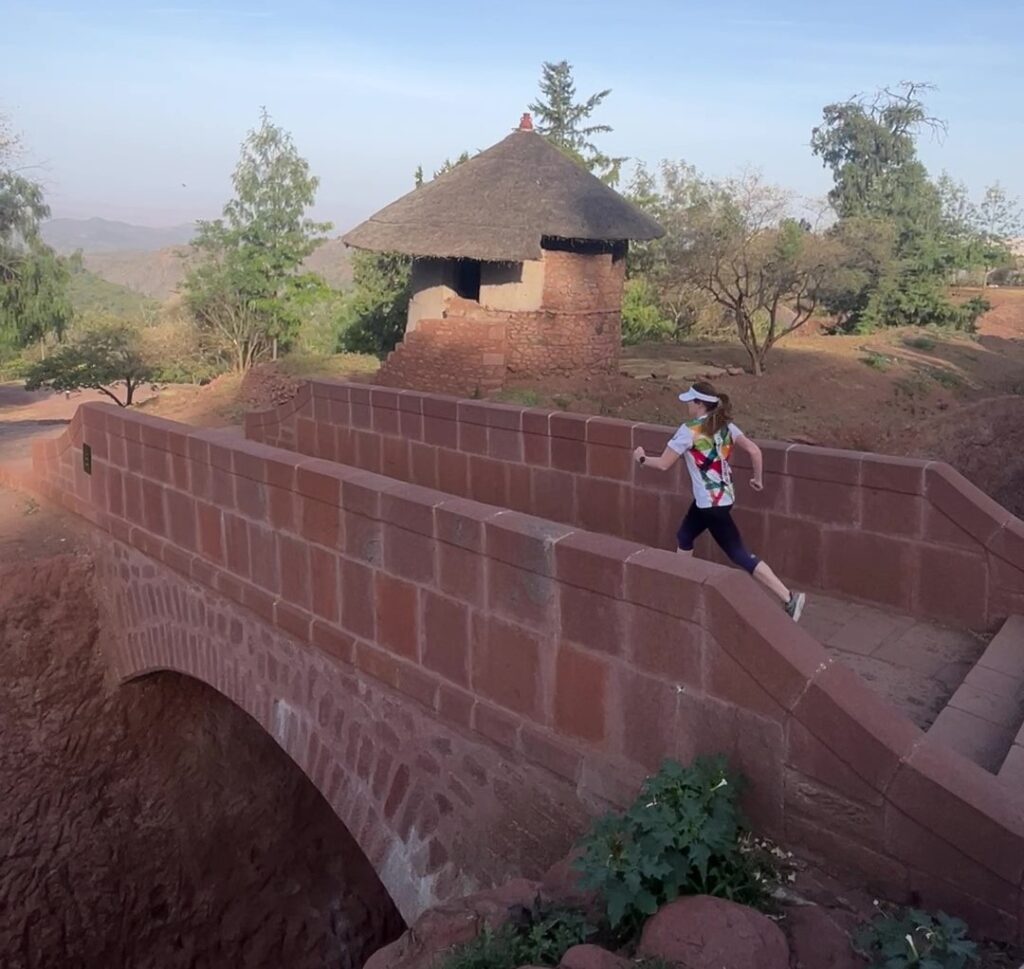
Here we took some amazing videos amongst mud houses and a bridge and, most colourful, locals with the typical white robes, youngsters going to school, ladies carrying wood… and everybody smiled and commented on our run. Some even said: “hey lady, can I run with you?” 👍
We felt safe at all times, by the way. No problem running here.
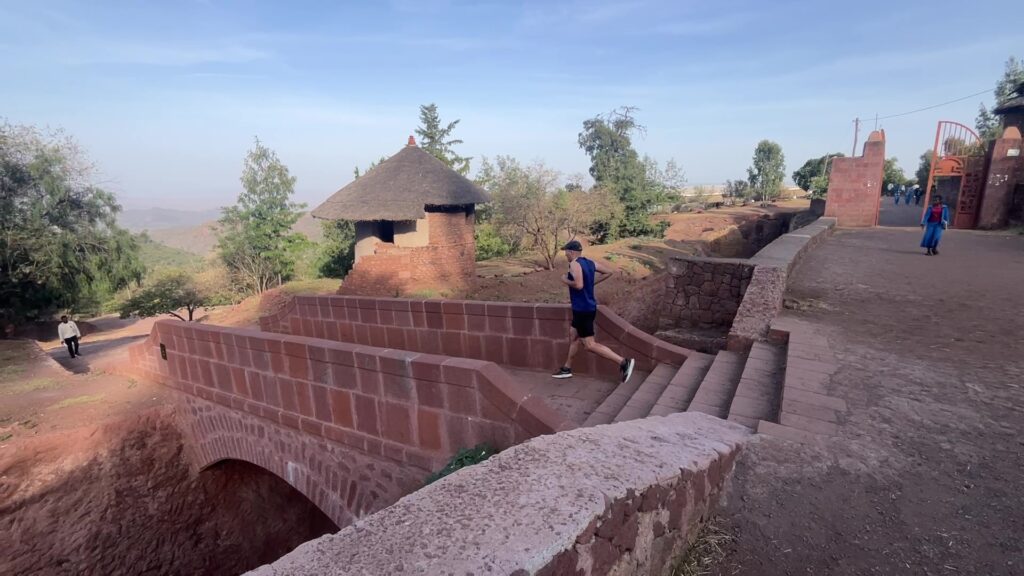
We did see a soldier in uniform walking slowly with a rifle: he was holding it in a curious position, which I saw then later, holding it from the cannon 😀
The pollution was bearable (for an African city) although in some places there were fires so it was a little annoying.
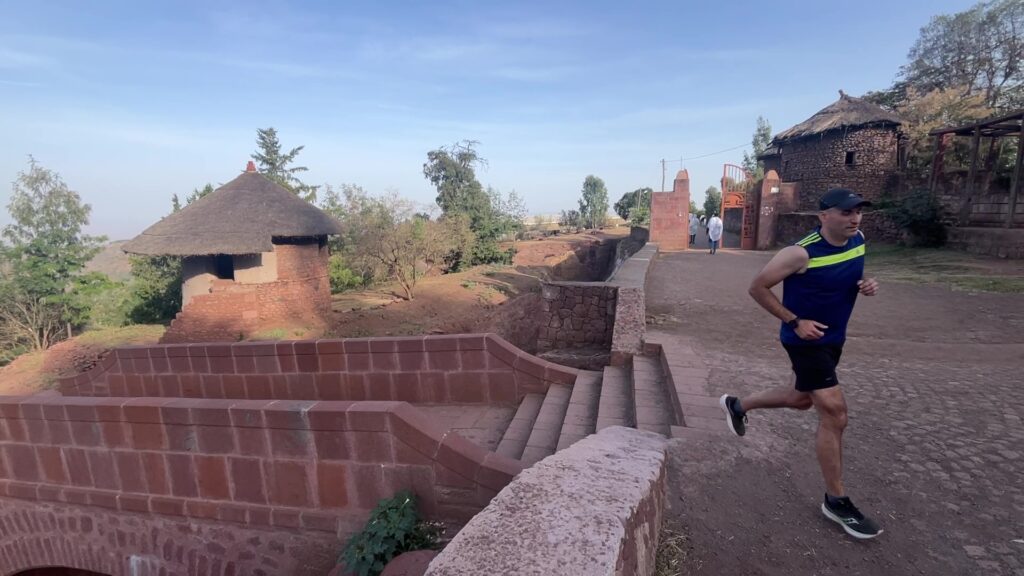
In general, an amazing run, perfect training: altitude and hill training as well as tourist attractions!
Our second run in Lalibela – running with Little Naus!
We enjoyed our run so much that we decided to run again the following morning, trying to do a longer loop. Starting again in the great tree in front of the college, a fig tree according to our guide.
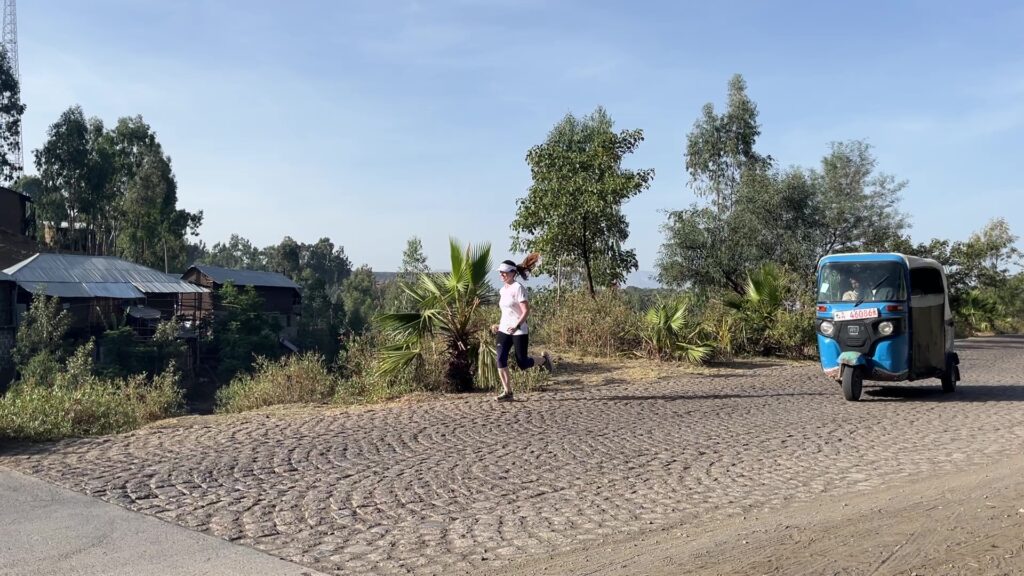
So, on a Friday morning, our third day in Lalibella, we went for our second run, and it was as amazing as the first one.
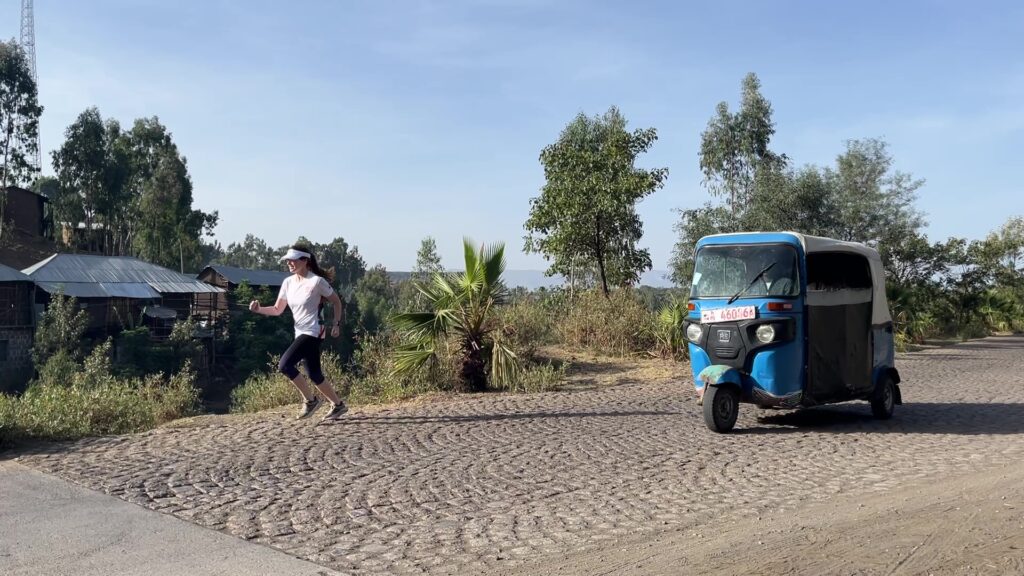
We did a 3kms loop and we did struggle – well, I particularly struggled – with the altitude and the climb, because the run started with 1.2km uphill to reach the northern cluster of churches.
The locals praying
But it was worth the climb, though. Running amongst the locals with no tourists, inmersing in the life of this African city which was waking up and seeing many locals praying, dressed in traditional white, in front of the rock-hewn ancient churches, was an experience like no other.
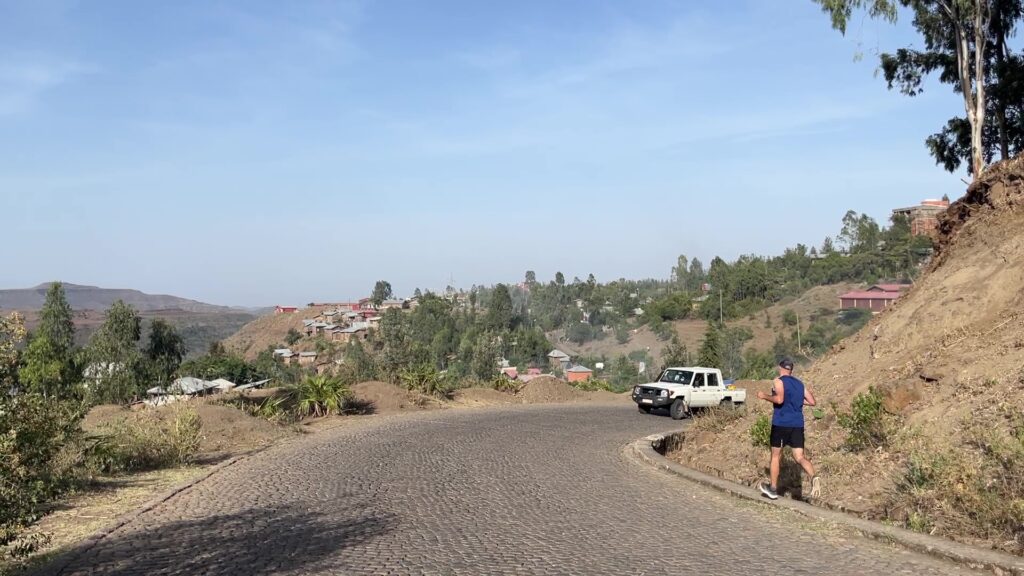
A memory to remember.
As we stopped in front of the Beta Lumb church at 7am, with the sun still low in the sky casting long shadows, we found ourselves amongst many locals dressed in the traditional white robes praying in front of the church.
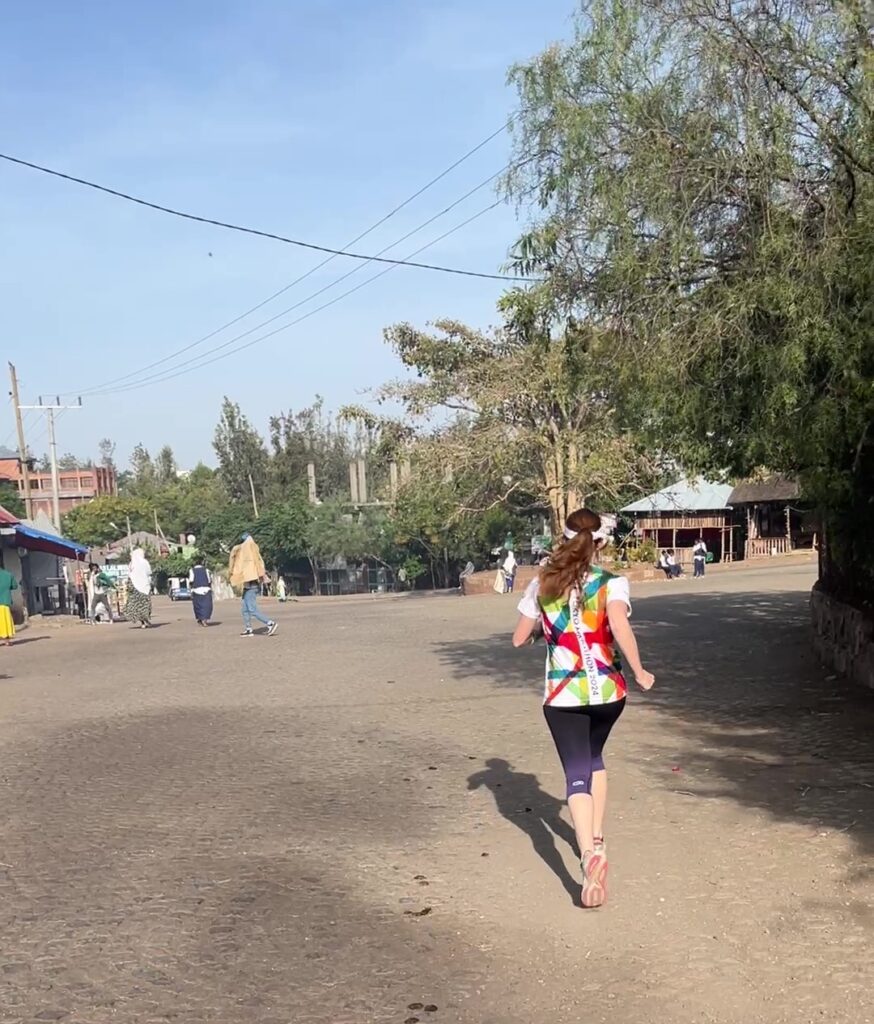
I was recovering my breath after the climb, but I had the energy to think how lucky I was to be there at that moment. No tourists, no souvenirs, no prefabricated attractions.
Local life
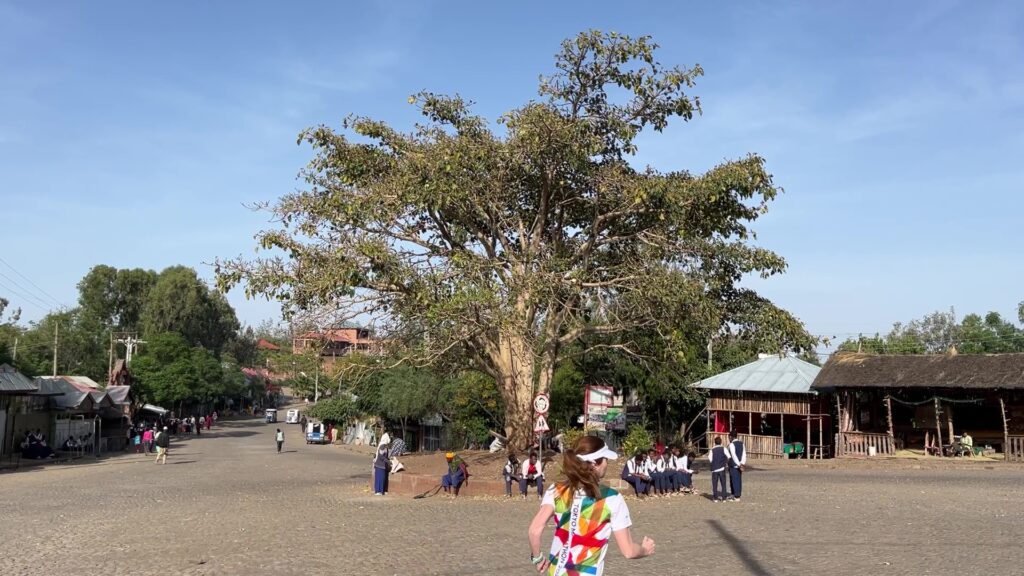
During the rest of the run, we turned into an attraction ourselves, as the locals shouted at us, the kids said “hello” and “money money” and they asked us “what’s your name?” and “where are you from?”, and we answered… although it was difficult as I was breathing very heavily due to the lack of air!
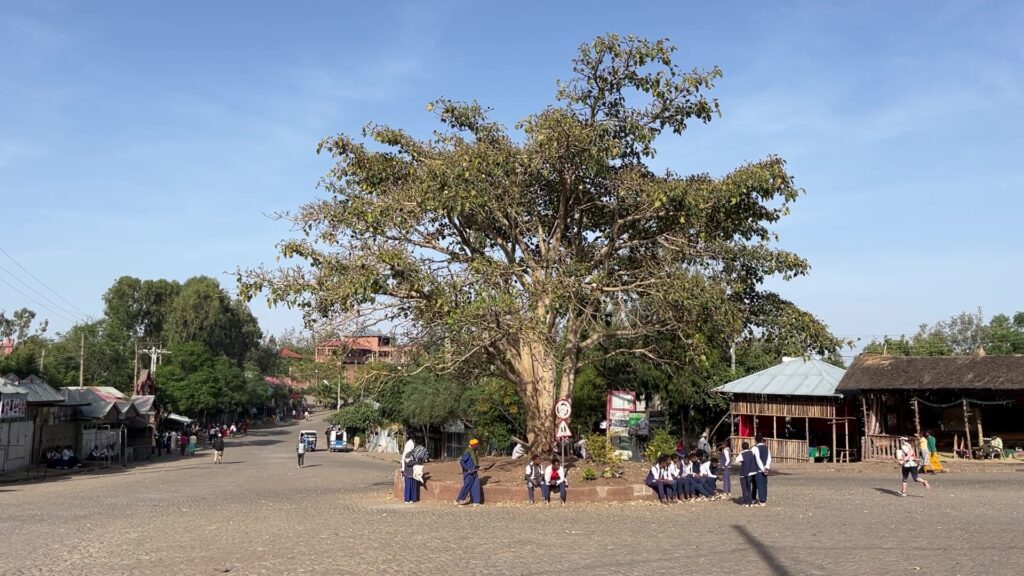
The tuk tuks passed us by and people inside shouted things like “hurry, hurry” or “come on” with their basic english, and I was so happy to have the opportunity to run here.
A kid runs more than 2kms with us… in sandals!
At some point, a kid named Naus started running with us.
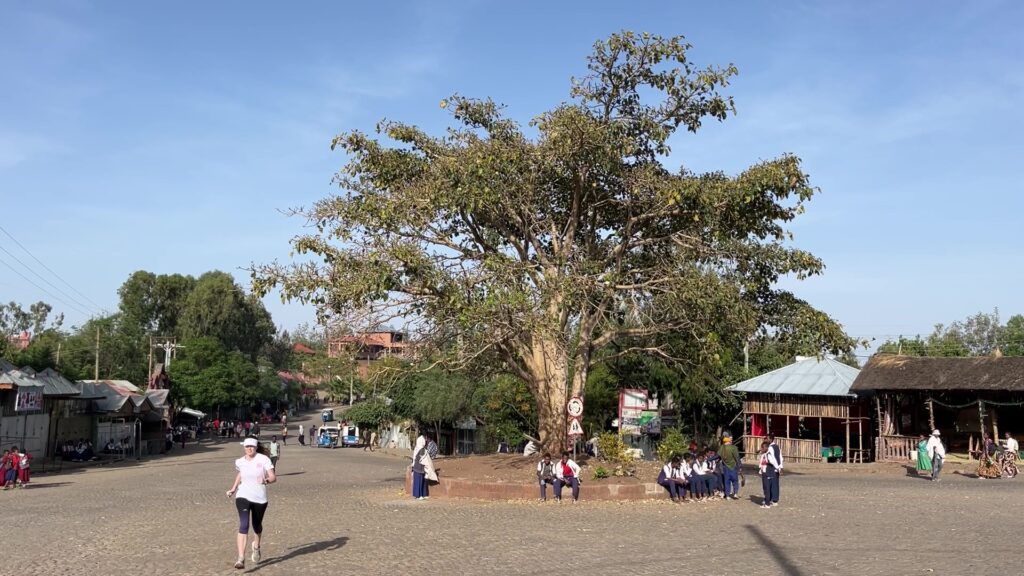
I know that because he told me his name while running: much faster than me, by the way.
He was dressed with a football shirt and kept running with me and encouraging me with “come on come on”. He even gave me a yellow flower!
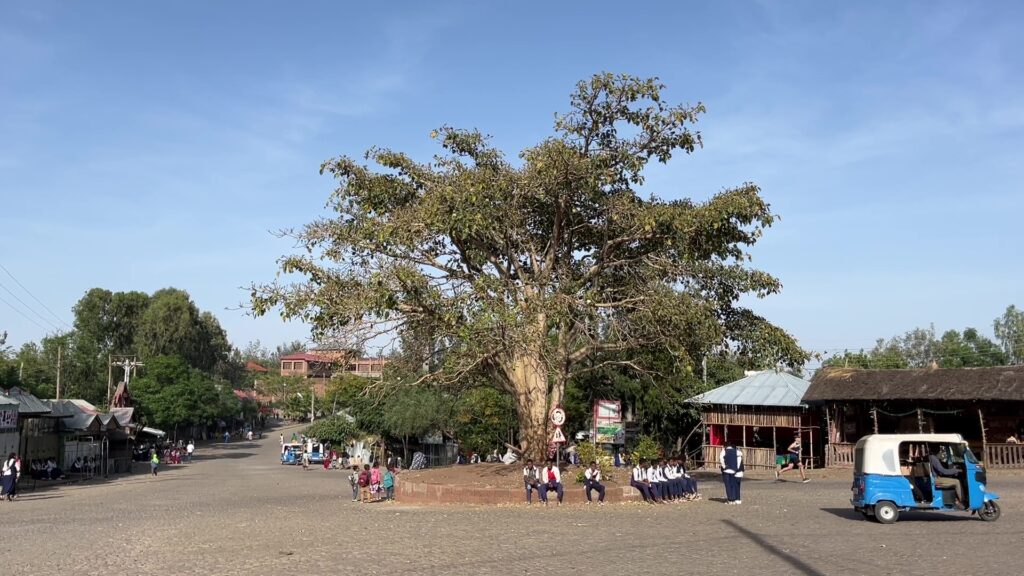
We finished our run, again, running in a last circle around the magnificent fig tree in front of the polytechnic college.
And we said goodbye to Naus, who had run more than 2 kilometers with us… with sandals! We normally do not give money to locals, but we did give something to Naus, because he had made our run more enjoyable and, my gosh, was he persistent!
Even Strength Training!
We could also squeeze in a couple of strength training sessions in the afternoon, in the terrace of our hotel, hotel Tabor.
We were the only guests in the property and the owner brought us…a mat!
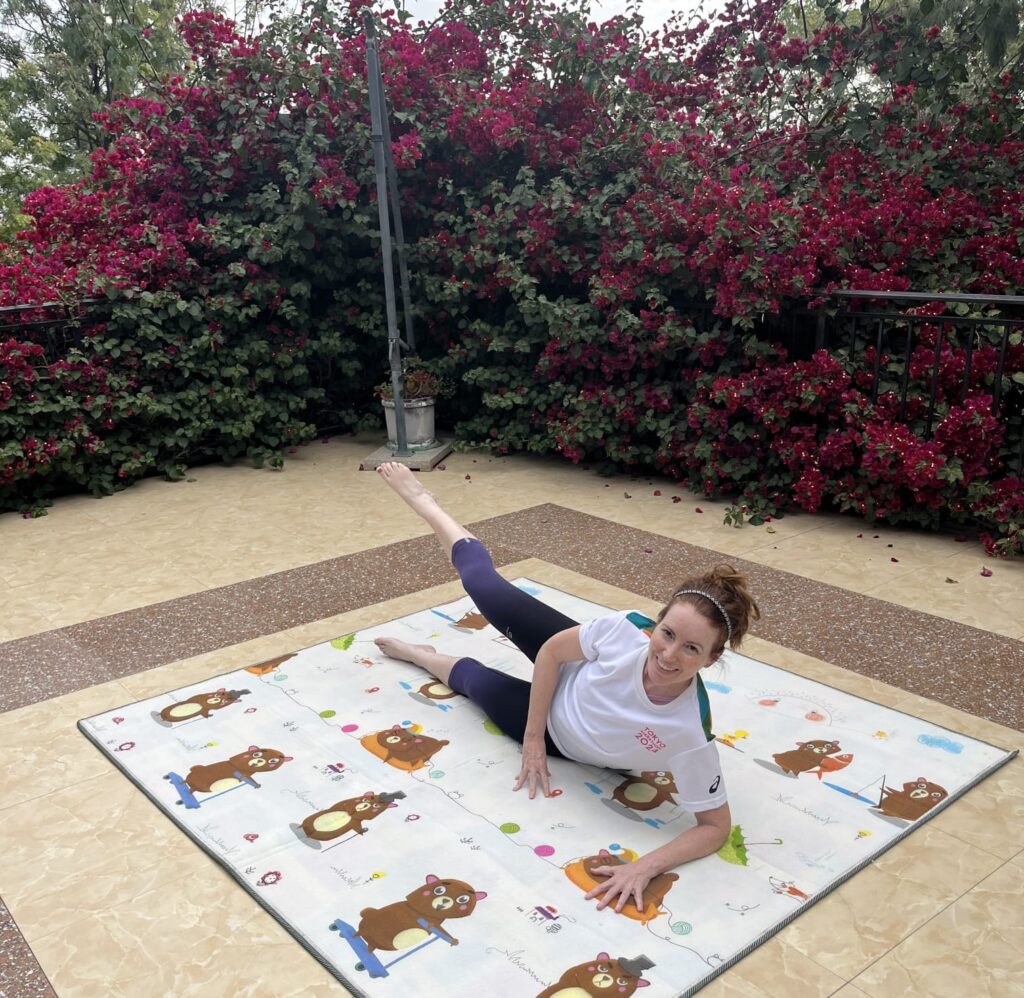
So funny, as it was a mat for children to play, but it did the job 😆
🍜 Carboloading 🍝: What to eat in Ethiopia if you are a runner
In Lalibella we order grilled fish from Lake Tana and stir fry chicken in the relaxed and nice terrace of restaurant “Ma’Ed“, with views of Lalibella (not great, but curious and real) and the beautiful mountains.
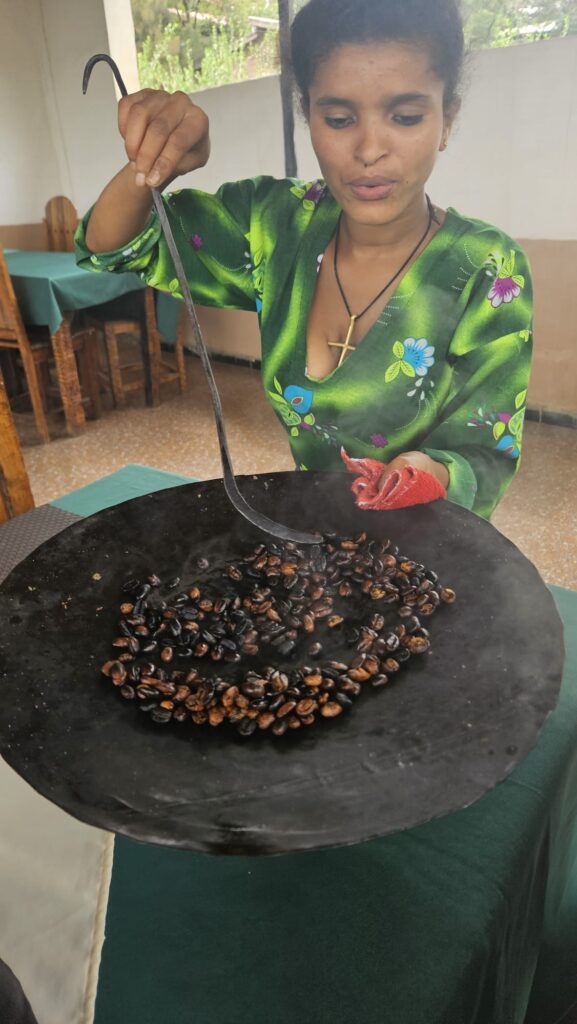
We were surprised by the appetizer!
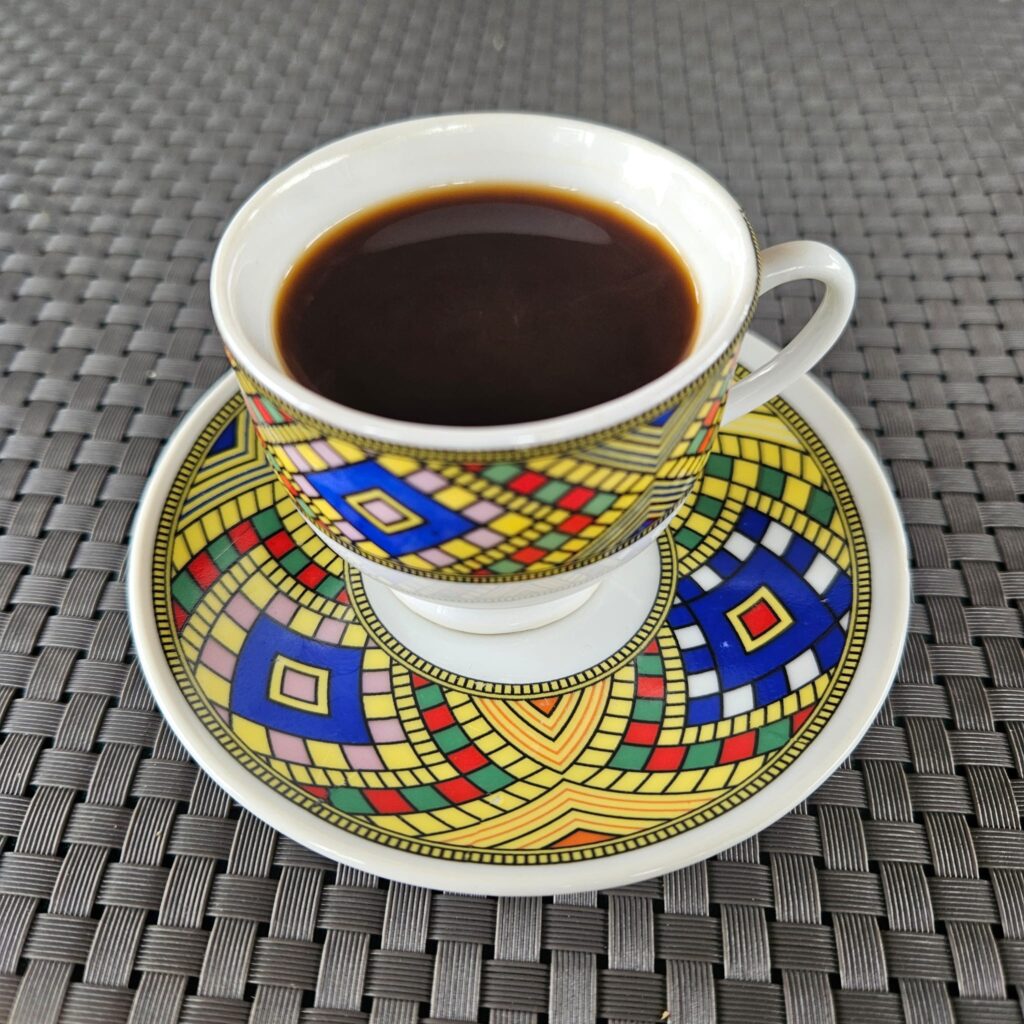
Because they brought us… Guacamole!! 🤣🤣 Not very Ethiopian but very tasty.
About Ethiopian Cuisine
Ethiopian cuisine features a variety of dishes that are rich in carbohydrates, often as a result of the use of staple grains and legumes. Here are some good ones!
- Injera: Injera is a fermented flatbread made from teff flour (sometimes mixed with barley, wheat, or sorghum). It is a central element of Ethiopian meals and is used as both a plate and a utensil to scoop up other dishes.
- Kita: A type of unleavened bread, often made from wheat or barley flour, fried or baked. Variants include sweetened kita with sugar or honey.
- Dabo: Ethiopian bread, often made from wheat flour and sometimes flavored with spices or honey.
And what about protein recovery? Ethiopia’s got you covered! And the nicest thing is that you can find plenty of plant-based protein, as well.
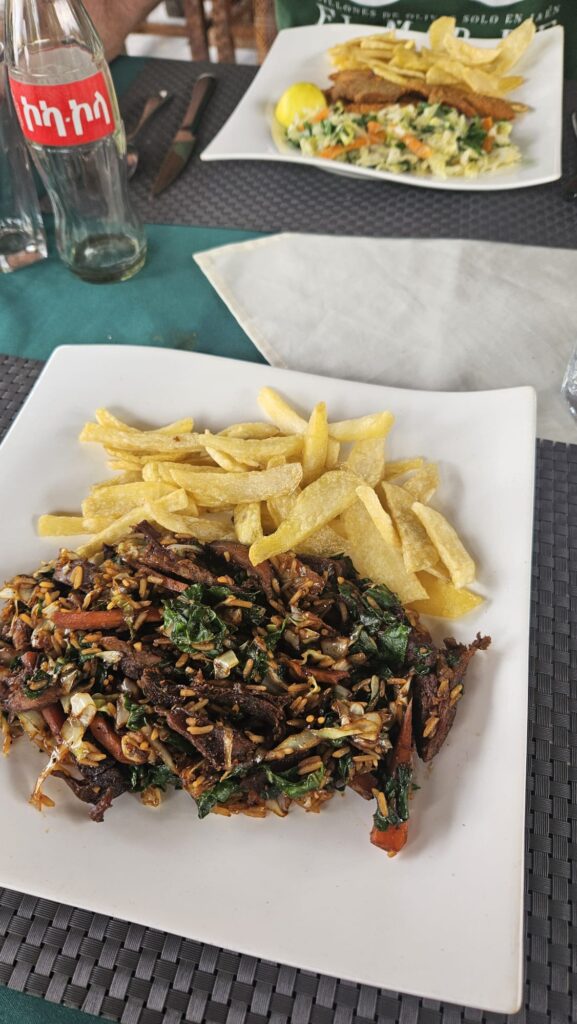
The three next dishes are blant-based, as they are legume-based:
- Shiro: A stew made from powdered chickpeas or broad beans mixed with spices and cooked into a thick sauce. Often served with injera.
- Misir Wot: A spiced red lentil stew cooked with berbere spice mix.
- Kik Alicha: A mild stew made from yellow split peas, onions, garlic, and turmeric.

Map
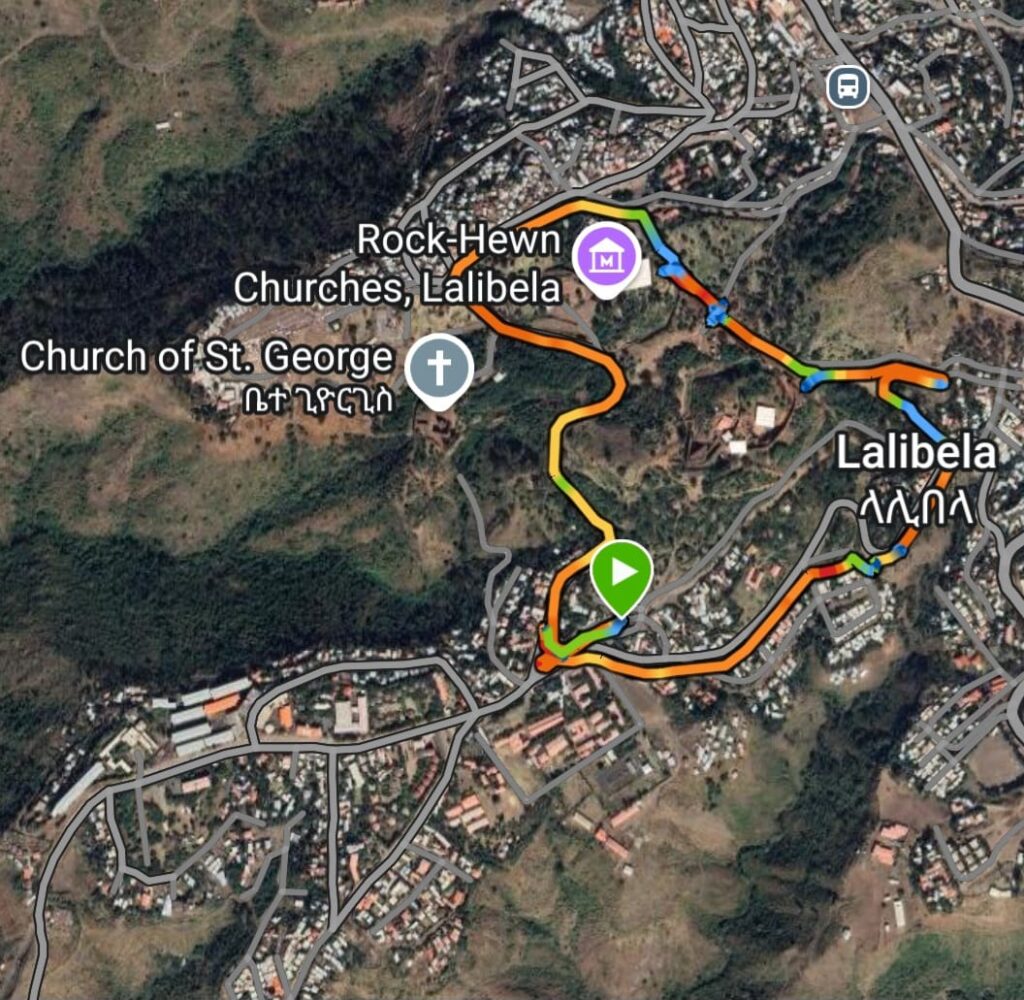

Useful information
🏃 2k to 6k Run in Lalibela, Ethiopia. You can shorten it or lengthen it.
👟 Urban, but dirt paths. Not the whole course is paved! Both shoes for asphalt or for trail are ok.
✅ Amazing scenery. Possiblity of enjoying the life of Lalibela without tourists.
✅ Training in altitude: with its pros and its cons….
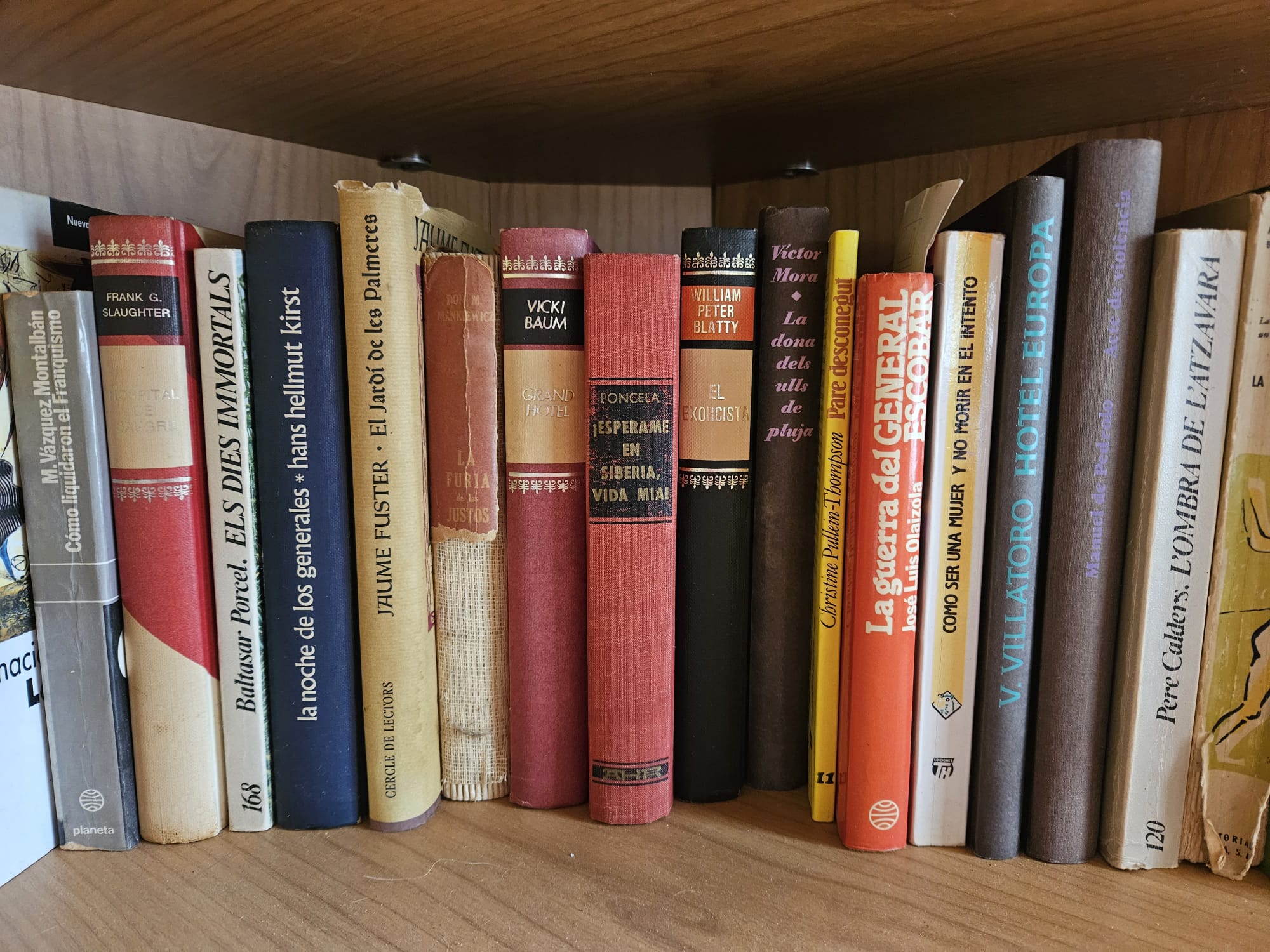
One book
I loved reading this book because it is beautifully written, strange at times, but especially as it talks about the Ethiopians fighting against the Italian Faccio with so many details, that I learnt a lot about the way people think and live here.
Then I would discuss details with our guides; like, for instance, the way women mourned the fallen…
(“They wore their dresses inside out and threw themselves earth at their faces”), the way they fought in the war (they sang, they learnt how to use the rifles and make powder).
The Shadow King, by Maaza Mengist
Maaza Mengiste’s novel, The Shadow King, is a rich, thought-provoking, and beautifully written work that offers several compelling reasons to be read.
The novel is set during the Second Italo-Ethiopian War (1935-1937), a pivotal yet often overlooked moment in history. It sheds light on the Ethiopian resistance against Mussolini’s forces, offering a narrative rarely explored in global literature.
By focusing on Ethiopian perspectives, The Shadow King challenges the Eurocentric portrayal of World War II-era conflicts, providing an African voice to a global historical conversation.
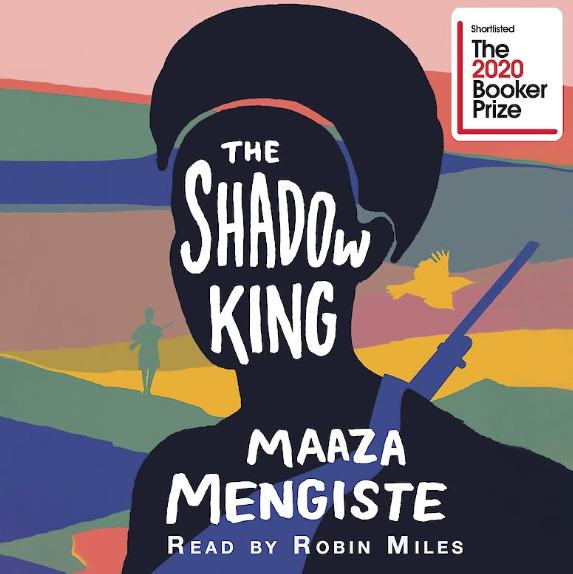
Plot Summary:
A gripping novel set during Mussolini’s 1935 invasion of Ethiopia, The Shadow King takes us back to the first real conflict of World War II, casting light on the women soldiers who were left out of the historical record.
With the threat of Mussolini’s army looming, recently orphaned Hirut struggles to adapt to her new life as a maid in Kidane and his wife Aster’s household. Kidane, an officer in Emperor Haile Selassie’s army, rushes to mobilize his strongest men before the Italians invade. His initial kindness to Hirut shifts into a flinty cruelty when she resists his advances, and Hirut finds herself tumbling into a new world of thefts and violations, of betrayals and overwhelming rage. Meanwhile, Mussolini’s technologically advanced army prepares for an easy victory. Hundreds of thousands of Italians―Jewish photographer Ettore among them―march on Ethiopia seeking adventure.

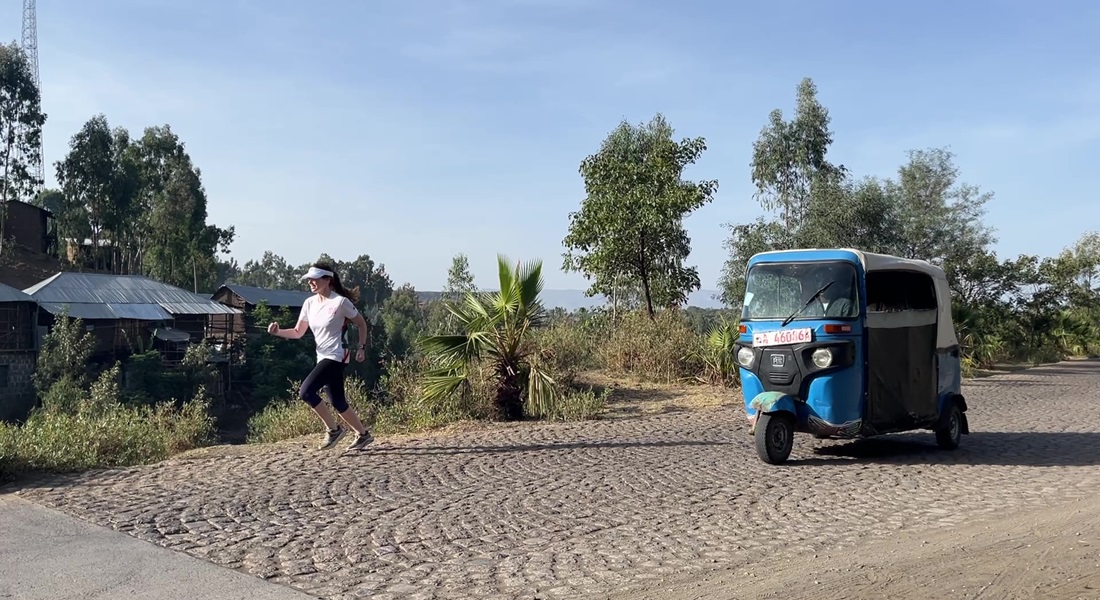
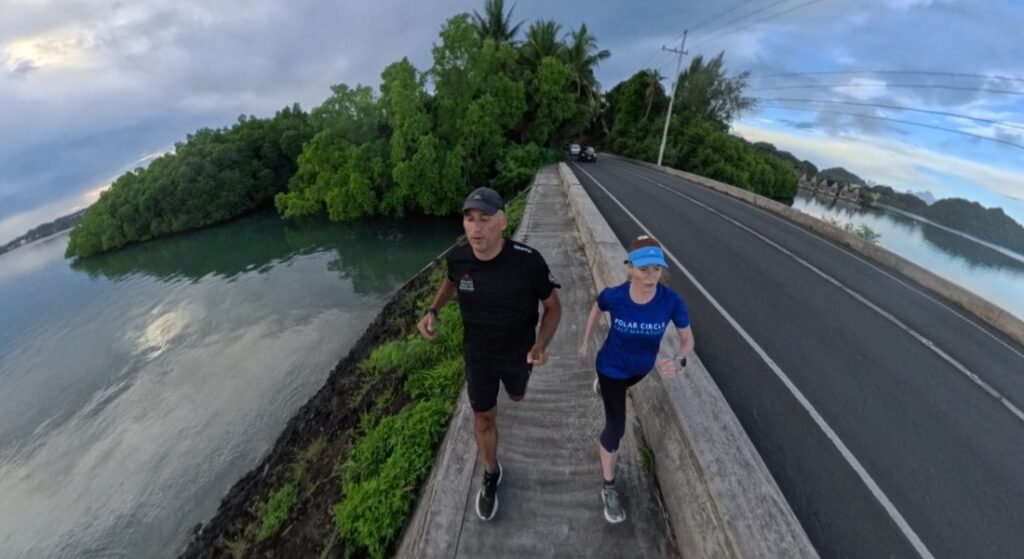

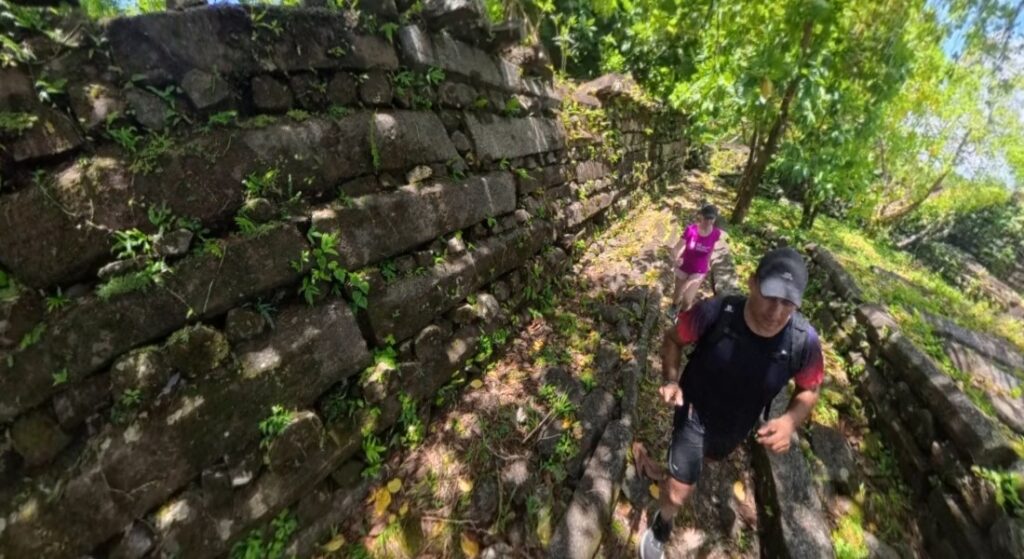
One Comment